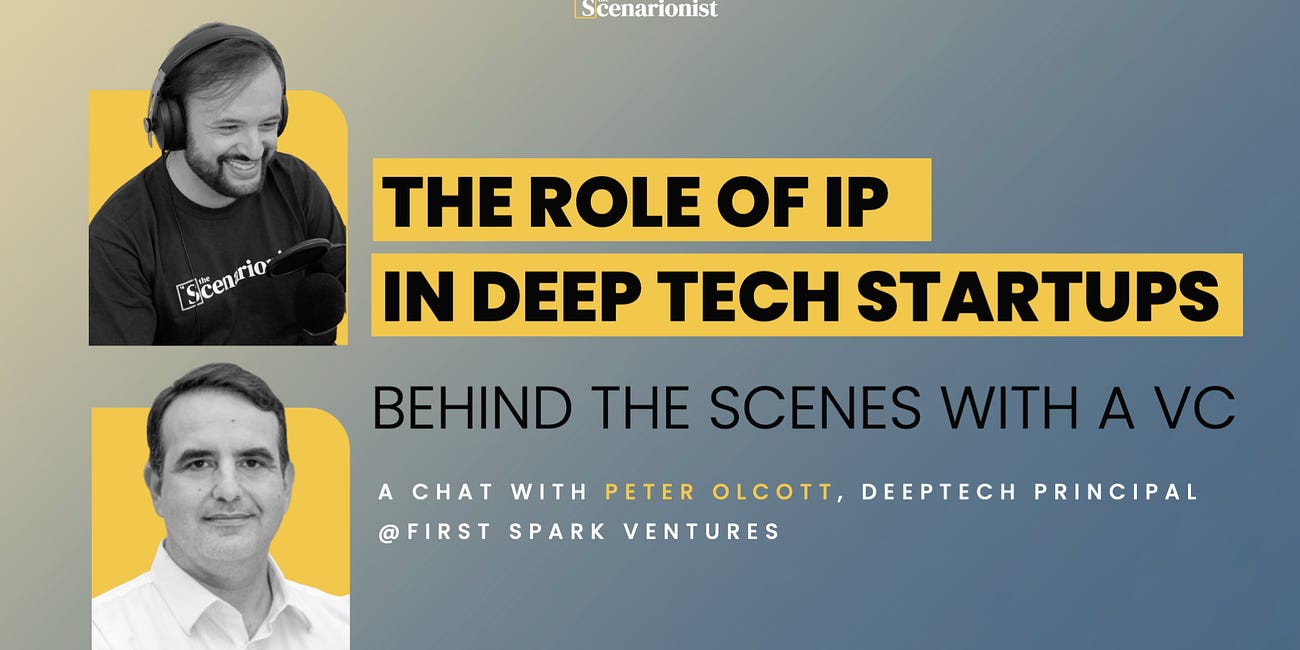Welcome back to Deep Tech Catalyst, the channel where science meets venture!
Today, we're honored to have Arkady Kulik, Founding Partner @ rpv, joining us.
In this session, we'll delve deep into the journey of introducing groundbreaking technology to the market, with a keen focus on the pre-seed stage in Deep Tech. From understanding Technology Readiness Levels (TRL) to navigating the complexities of intellectual property rights and market traction, we will provide invaluable insights and strategies tailored for approaching the first VC interview.
Join us as we uncover the key principles and actionable approaches to unlocking the full commercial potential of Deep Tech innovations.
Let's get started!
🎧 Prefer to listen?
Before diving into the episode, we would like to thank the individuals and supporters who have helped us keep this valuable entrepreneurial channel open-source. 🙏🏻
If you would like to collaborate with us, you can reach out at info@thescenarionist.org
Today’s edition is supported by Hello Tomorrow.
The Hello Tomorrow Global Summit is an annual event that gathers over 3,000 people from across the world, all with one thing in common. The belief that science and technology hold untapped potential to solve our planet and society’s most urgent challenges, and the motivation to make it happen.
Taking place on 21st-22nd March 2024, the Hello Tomorrow Global Summit brings attendees to the forefront of new ideas, uncovering the most promising new projects across all industries: from synthetic biology to quantum physics to carbon capture, fostering collaboration between industry leaders, investors, startups, researchers and experts in the deep tech ecosystem from all over the world.
Join to find your next business partner, investor, or startup to invest in, discover the next big thing in your industry, or network amongst key stakeholders.(*)
🚀 Making the Leap: From Ground Zero to Pre-Seed
When it comes to envisioning a plan for a startup that’s currently at Technology Readiness Level (TRL) 3, the question arises: where to start? The key is to have a clear understanding of how you’re going to develop your prototype and the exact manner in which you’ll deploy your first device in your target operating environment.
Consider all factors, from environmental conditions like noise and temperature to the ways users will interact with your product. The most significant milestone to achieve with pre-seed funding, grants, or any early-stage funding is the deployment of a prototype used by real-life users.
Whether these users are actual paying clients matters less at the pre-seed stage. However, it becomes more crucial at the seed and Series A stages. At these stages, it’s essential to have people using something that you have built.
🪜 Understanding TRL in the Early Stage Deep Tech
Technology Readiness Levels (TRL) serve as a standardized metric for gauging the maturity of emerging technologies. This systematic approach involves assessing various projects against predefined criteria across nine TRL stages, ranging from conceptualization to full commercialization.
Why do they matter?
Understanding these TRL stages provides a roadmap for navigating the development and commercialization journey of emerging technologies, facilitating informed decision-making and resource allocation.
Here's a concise breakdown of the first six for our episode's purposes:
TRL 1 is an idea
TRL 2 is kind of a theory
TRL3 is some early experiments
TRL 4 is when a technology is getting into the stage when they're testing a specific component of their product in the lab environment
TRL 5 is the full product in the lab environment
TRL 6 is the full product in the actual environment where it should be used
For further exploration, you can dive into TRLs here.
🧑💻 Approaching Pre-Seed VC Interviews in 3 Steps
Venturing into the realm of pre-seed VC interviews necessitates a strategic approach, particularly when dealing with Deep Tech starting from a STEM background.
Thorough preparation, personalized communication, and honesty are the pillars of success in navigating pre-seed VC interviews. By understanding your investors and tailoring your approach accordingly, you can enhance your chances of securing funding and cultivating lasting partnerships.
Here are 3 steps to kick-start your preparation:
Step #1: Do Your Homework
The first step in any fundraising journey is to comprehend your core audience. What drives these individuals to invest in your venture? Gaining insights into their motivations forms the foundation for effective communication.
Utilize online content (podcasts, blogs, public releases) to understand investor motivations.
Once equipped with this understanding, identify investors whose motives align with your venture. Scrutinize their past investments, speeches, and interviews to customize your pitch.
Step #2: a Warm Intro is Better Than a Cold Call
Personalization is the key. Tailor your outreach efforts to resonate with each investor. Opt for warm introductions over cold calls, as they usually yield better results. Avoid generic cold emails; instead, ensure your communication is compelling and relevant to the recipient.
Preparation for interviews involves anticipating a wide array of questions, from technology and business models to ethics and societal impact. While providing answers is important, knowing which aspects to highlight for each investor is crucial.
Step #3: Integrity First
Lastly, never underestimate the power of honesty. Integrity is vital in building long-term relationships with investors. Be genuine in your responses, attempting to deceive investors is counterproductive and erodes trust. Any attempts to hide information or mislead investors will inevitably backfire.
🤼 IP, Tech, and Competition
In the complex landscape of technological intellectual property (IP), it's crucial for scientists to understand what to prioritize when engaging with venture capitalists (VCs).
The considerations largely hinge on the development stage. For instance, during Series A, it's essential to have patents filed for the core IP, complemented by a well-articulated IP strategy for clarity. Moreover, a robust defense plan for products across target markets should be in place.
In contrast, at the pre-seed stage, outlining a clear trajectory for IP protection, indicating intentions for future filings, is sufficient. While formal documents may not be necessary at this stage, a thorough examination of these aspects prior to engagement is crucial.
Competitors Mapping 101
Charting the competitive landscape and securing a strong market position is vital, particularly in the early pre-seed phase where the technology takes precedence over the company. Instead of focusing solely on existing competitors, assessing competition within technology domains, including indirect competitors, is of greater importance.
For example, in Advanced Computing, determining the superiority of one's technology among various approaches such as organoid intelligence or photonic computing is critical. Utilizing resources like language models (LLMs) or specialized subscriptions can assist in a comprehensive competitor analysis and technology assessment.
When to Size the Total Addressable Market (TAM)?
Determining the first addressable market can pose challenges, particularly for scientists transitioning into entrepreneurship.
While total addressable market (TAM) analysis is essential, emphasizing technology superiority over immediate market size holds sway, particularly in deep tech ventures at the pre-seed stage.
Understanding the beachhead market is crucial, followed by a focused expansion strategy post Pre-Seed.
Avoiding dispersion across multiple markets early on is advisable; instead, channel resources into a single market for optimal traction and testing.
Moving beyond pre-seed towards seed and series A stages, attention shifts towards team composition and advisory board strength, underscoring the importance of assembling a capable and diverse team to drive the venture forward.
⚖️ Scientific vs Entrepreneurial Spirit in Startups
The ideal team composition pairs a seasoned scientist, boasting a decade or more of profound expertise in a specific scientific domain, with an entrepreneur who has demonstrated industry-relevant prowess.
For instance, picture a scenario where a neuroscientist, armed with over a decade of research experience in neuromodulation, is complemented by a neuro-entrepreneur who has previously navigated ventures in neuroscience, even if not in the exact technology domain. This synergy forms an optimal match, although such perfect alignments are seldom encountered in reality.
The Best-Case Scenario
The next best scenario is a scientist with entrepreneurial aspirations who is open to guidance and feedback. It’s vital that this individual not only listens but also integrates valuable insights into the startup’s operations. A scientist with the ambition to transition into an entrepreneurial role can still be a significant asset to the team.
On the other hand, a team composed solely of scientists lacking entrepreneurial drive or managerial acumen is unlikely to flourish. Such ventures typically lack the essential entrepreneurial spirit necessary for success, leading to a general reluctance to invest in them.
📶 Focus on the Fundable Events Timeline
When charting the course of a very early-stage startup, it’s crucial to map out a timeline of milestones that align with the capital needs for the first 2 to 3 years after securing investment. This timeline, often referred to as a “fundable events timeline,” is a key component of a compelling pitch deck.
The Role of the Timeline in Different Sectors
The fundable events timeline provides a clear trajectory of growth and progress, which can lead to an increase in the company’s valuation and guide the timing of future fundraising rounds.
For example, in the medical devices sector, a well-articulated plan for obtaining FDA approval and insurance reimbursement is vital.
If your target market includes tech behemoths like Google or Intel, outlining steps such as prototype development, engagement with their R&D and product teams, and potential partnership discussions is essential.
Impressing Investors with Strategic Thinking
This timeline offers investors a glimpse into your strategic thinking and addresses their primary concern: how they will see a return on their investment.
Demonstrating foresight in planning and catering to investor needs can significantly boost the appeal of your pitch.
Including a fundable events timeline can set you apart, highlighting your strategic prowess and focus on investor interests.
Establishing Comparables and Constructing Timelines
For scientist-entrepreneurs embarking on their startup journey, identifying comparable companies can serve as a valuable benchmark. These comparables, typically sought during the pre-seed stage, provide insights into the trajectory and timelines of similar ventures. For instance, if a comparable company achieved certain milestones within a two-year timeframe from pre-seed to seed funding, it can serve as a useful reference for planning.
Utilizing Online Resources for Pitch Decks and Timelines
A ton of online resources exist to guide entrepreneurs in crafting pitch decks and fundable event timelines. One notable resource is “Only 10 Slides You Need in Your Pitch Deck” by Guy Kawasaki, a renowned expert in the field. While distilling your story into just 10 slides may seem challenging, this framework encourages focus on the essential aspects of your business, ensuring clarity and relevance in investor communications.
💰 Streamlining Budgetary Planning
In budgetary planning, it’s essential to adopt a conservative approach. This involves basing projections on industry averages rather than optimistic assumptions. Even with a robust strategy, caution is advised, especially in financial modeling.
It’s beneficial to seek advice from mentors and advisors, particularly in areas outside your expertise, such as intellectual property or financial forecasting.
Balancing Budget with a Focus on R&D
When determining capital use, effective budget balancing is crucial. R&D often constitutes a significant part of the budget, and a conservative approach to financial planning is recommended, regardless of whether it’s for personal or company finances.
Even if you’re confident in your due diligence and strategy, it’s wise to use average rates and valuations in your financial model until your venture’s success is proven. Clarity about your expenditure and seeking advice, especially if you’re new to entrepreneurship, can be invaluable.
For financial forecasting, if a cost is uncertain, it’s safer to overestimate. If revenue or income is uncertain, it’s better to underestimate or even assume zero.
This conservative approach enhances your chances of success. If your financial model paints an overly optimistic picture and reality doesn’t meet expectations, it can pose challenges for you and your investors. Conversely, if your projections are grim and reality surpasses expectations, it’s a reason to celebrate.
This is all for today!
Wanna be more involved?
👉🏻 Follow our LinkedIn page and drop a DM!
👉🏻 Write us a line here: info@thescenarionist.org
See you next week! 👋























